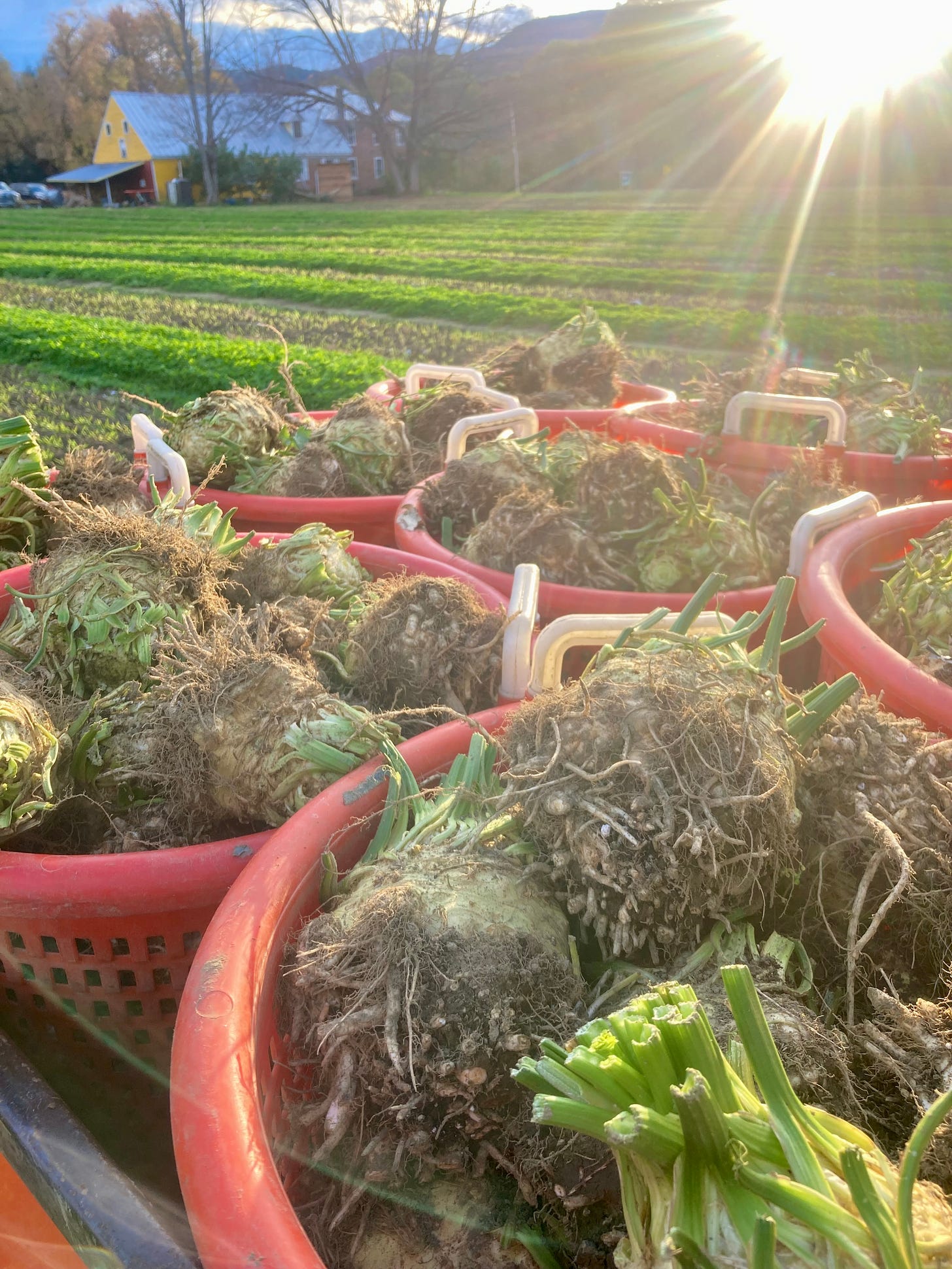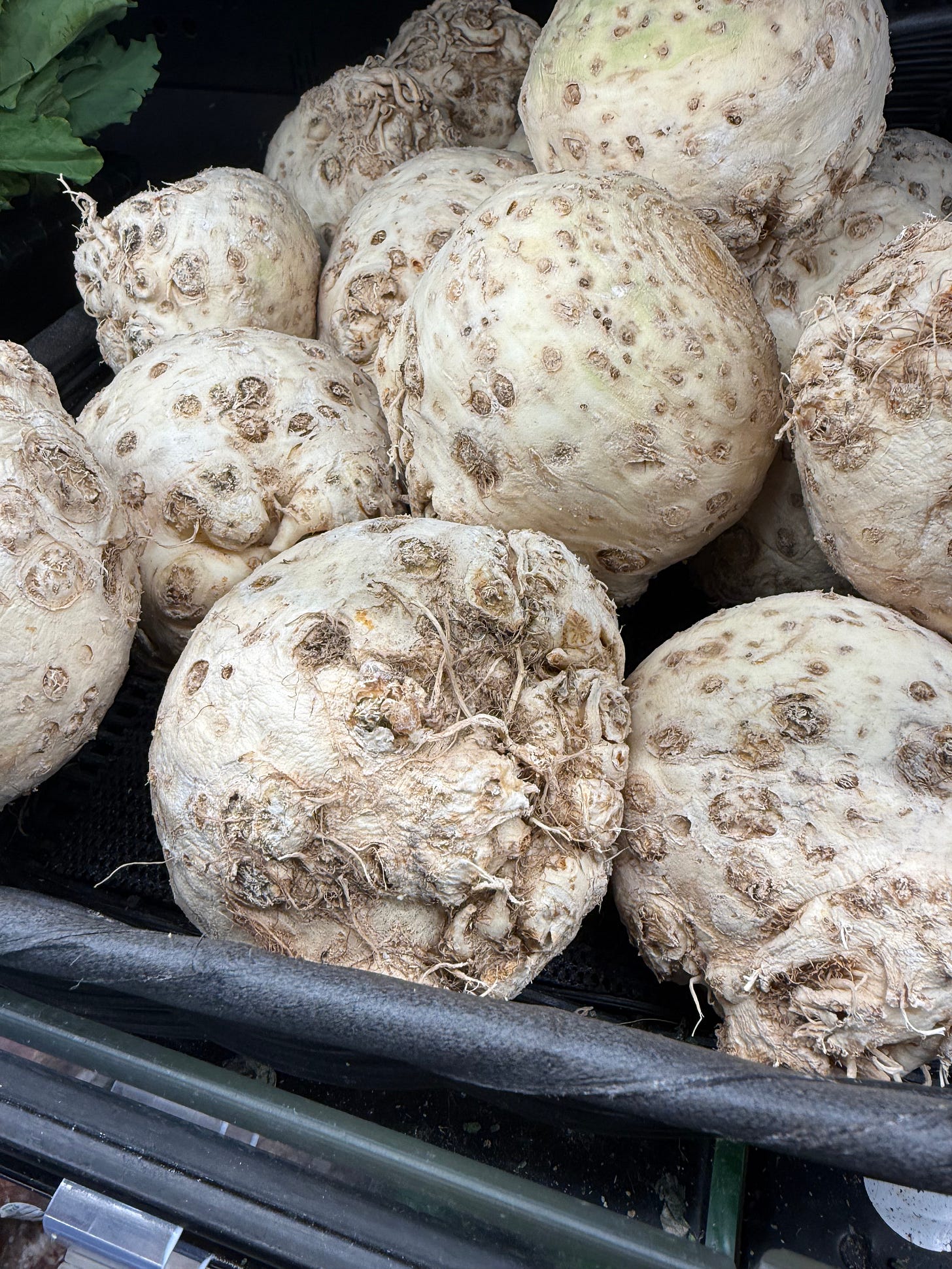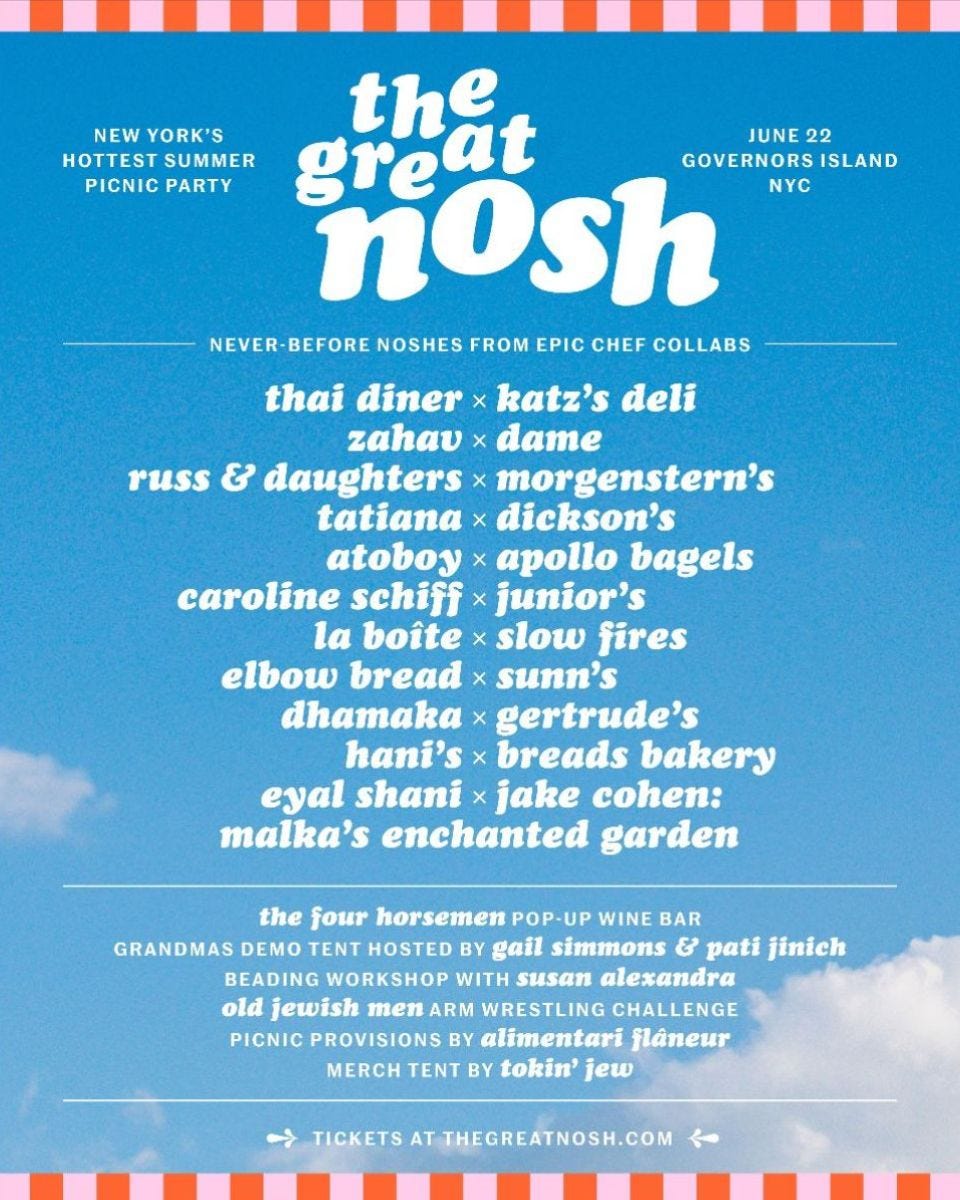Issue #206: Celery Root Confit with Citrus, Olive Oil, and Dill
A Very Big Nosh, Traditional Turkish Vegetaable Preparation, Our Wedding Menu
Since last September, I’ve been working with the Jewish Food Society to help create a new celebration of Jewish food and culture called The Great Nosh, the best thing to hit New York City since sliced pastrami! Yesterday, ticket sales went live.
The Great Nosh is a picnic on Governors Island with a carefully curated line-up of chefs from the best restaurants we know, who are pairing off for cross-cultural collabs. For example, Katz’s Deli x Thai Diner, Atoboy x Apollo Bagels, Tatiana x Dickson’s Farmstand Meats, and Hani’s x Breads Bakery. Among the unique offerings you’ll be able to enjoy are “schnitz’ & chips” from Zahav x Dame and a sabich bar from Malka’s Eyal Shani with homemade pickles by Jake Cohen. There will be a natural wine bar from The Four Horsemen, live music, a “Summer Camp” beading workshop with Susan Alexandra, intergenerational cooking demos hosted by Gail Simmons and Pati Jinich, plus much more.
In the words of Jewish Food Society founder Naama Shefi, who had the visiion for this giant picnic celebration, “The Great Nosh is a place to find joy in these trying times, to celebrate Jewish culture, and the diversity of New York City.” Buy your tickets today by clicking on the button below. See you there! —Mitchell
For Passover on our neighbor’s farm this year, I agreed to bring tzimmes. That’s the Jewish side dish that’s a mishmash of mostly carrots, but also prunes and sweet potatoes (and sometimes meat) all cooked together in a more-sweet-than-savory, orange-and-cinnamon-infused braise. The farmers said they would drop off a load of carrots they had stored over winter in their cellar for me to use.
I was away when the farm delivery was made. Nate informed me there were no carrots, the main ingredient. “What did we get?” I texted.
“A bag of potatoes, some gnarly round things covered in dirt, and some other things covered in dirt.”
“Not helpful,” I replied “Are you sure there are no carrots?”
“Of that, I’m sure.”
When I got home, I verified his report. I had a five-pound bag of potatoes, a pile of watemelon radishes, and the gnarly things I recognized as celery roots‚ more than I’d ever seen.

Some people distinguish between celeriac, the oversized, round, thin-skinned celery roots that are grown to be eaten, from the smaller, gnarlier, roots of celery that are grown to produce celery stalks, but the roots of which can also be eaten. I refer to them both interchangeably as celeriac or celery root. But there was little question these roots I was looking at had once been topped by celery.
I often have celeriac in my fridge. It keeps a long time, has a distinct flavor, and a little goes a long way. I add celery root to my chicken soup and to my hash. I like it julienned in slaws, especially rémoulade (see Issue #197). But what would I do with 10 pounds of the stuff? Some would end up in my tizmmes. But what about the rest?

Fast forward several weeks. I was scrolling through the endless montage of recipes that comes into my Instagram feed when I saw an Ottolenghi recipe for a confit of celery root with olive oil, orange, and dill. The headnote said it was adapted from a traditional Turkish preparation. Not something I’d heard of, but I had all the ingredients, and like most of Ottolenghi’s recipes, it sounded and looked delicious.
That evening I set to work on the gnarly roots, caked with dirt and now mushy in places. The nice thing about having so much of something is you can peel and resect with abandon.
Aside from peeling my roots, which would have taken a power washer to avoid, I followed the recipe pretty much as written. Though I love Ottolenghi’s food, to be honest, sometimes I feel his team makes recipes more complicated than they need to be. Soak this, blanch that, wipe out the pan. I usually ignore all that. This time I didn’t have to. It was super easy.
I put the celery root in a dutch oven with almost all of the ingredients, covered the pan, and let it bake for about an hour and a half until soft. I was in another room, but as the timer was about to go off, the house filled with the most delicious aroma of earth, herb, and citrus.
Hard to say what was more delicious, the celery root or the fragrant oil in which it cooked. Over the next week, I ate both for lunch every day, first, as Ottolenghi suggested, mashed in pita with feta as the basis of a sandwich. But then, every which way—on bread with ricotta, mixed into beans, over rice. YUMMMM!
The Turkish name is Zeytinyağlı Kereviz Yemeği. I don’t know how to pronounce that. Nevertheless, this dish is going into my rotation. I’ve got a few large dinners coming up and you can bet it will be on the menu. I’m excited to cook it again. I encourage you to try it.
RECIPE: Celery Root Confit with Citrus, Olive Oil, and Dill
Makes 6 to 8 servings
2 pounds celery root (aka celeriac)
2 large oranges
2 lemons
2/3 cup extra-virgin olive oil
1 head garlic (about 9 cloves), peeled
1 bay leaf
1 teaspoon brown sugar
1/2 small red chili, thinly sliced if you like things spicy, or left whole if you don’t, or pinch of Aleppo pepper flakes
2 teaspoons sea salt
Freshly ground black pepper
Small bunch dill, roughly chopped, divided
1 tablespoon coriander seeds, toasted and cracked (optional)
Preheat the oven to 350°F.
If your celery root is large and relatively dirt free, scrub it with a brush to remove any dirt and with a sharp paring knife, trim the gnarly bottom of roots and crevices. You can leave the peel on, but if it’s too dirty or you prefer it peeled, you can peel the whole thing. Depending on size, cut in half and then into large wedges. Arrange them cut side down on the bottom of wide, shallow Dutch oven or other baking dish. If they are small, you can leave them whole, as I did.
Using a vegetable peeler, shave off a total of 5 wide strips of orange zest from the oranges and put them in with the celery root. Halve and juice the oranges, you should have about a cup, and add the juice to the pan. Peel 3 wide strips of lemon zest, and add them also, along with the juice of the lemons, about 1/4 cup. Add the olive oil, garlic, bay leaf, sugar, chili, salt, a generous amount of freshly ground pepper, and half of the dill, and mix to combine and coat. Spoon the liquid over the celery root wedges, cover, and set in the preheated oven for 90 minutes.
About every 30 minutes, remove the pan, turn the celery root over in its juices, baste, and continue baking until the flesh has softened (test it with the tip of a knife), the braising liquid has reduced and thickened, and the aroma is transporting. Remove from the oven, lift off the cover, and let cool 30 minutes or so. Sprinkle with the remaining dill and the coriander seeds, if using.
Serve as a side dish, a sandwich filling, a topping for crostini, or what have use. Use every drop of the fragrant oil and the confited garlic, as well.
Epilogue: Our Wedding Menu
During the week in which I was enjoying my citrusy celery root bounty, I happened to spend a night at the home of my friend Karen’s on Seneca Lake in New York’s Finger Lakes region. Karen and her late husband Dano ran one of my favorite restaurants, a Viennese bistro called Dano’s Heuriguer. They opened in downtown Ithaca during my senior year of college and later moved to the shores of Seneca. Nate and I were married there in 2012, and during the years of COVID isolation, when we rented a house on nearby Cayuga Lake, we ate there often. After a successful 35-year run, a few montsh ago Karen closed the restaurant and retired so she could devote her time to painting, her true passion.
Over dinner, Karen and I were sharing stories of things we’d recently cooked and I mentioned how I’d fallen in love with this celery root with orange and dill. She said, oh, that’s a traditional Turkish dish. I told her Ottolenghi had mentioned that in his head note. Then she surprised me. “We made that for your wedding.”
What?! You did? Like most people getting married, Nate and I didn’t each much of the phenomenal food Karen and Dano prepared for the 175 guests at our wedding. We were too busy hugging friends, taking pictures, dancing, being overwhelmed with joy at having everyone we loved together. I didn’t recall the celery root at all. Sure enough, I went into our wedding memories box to look for the menu and flipped through the photos. There it was: Turkish-Style Rutabaga, Carrot, Celeriac, and Peas with Orange Dill Sauce. (Sounds like a tzimmes.) Go figure.
.





